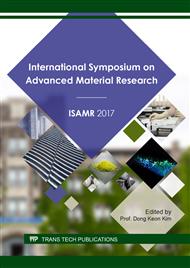p.300
p.305
p.310
p.315
p.321
p.326
p.331
p.337
p.343
Strength of Modified Concretes Curing without Care in Dry and Hot Climate Conditions
Abstract:
The speed of concrete curing and design concrete strength depend on the environmental conditions of construction site. Dry and hot climate conditions intensify the process of water evaporation from concrete and cause the concrete shrinkage and the loss of the potential concrete strength. The research work is devoted to study the layer changes of the concrete strength; determination of the minimum period of care for concrete; assessment of negative impact of dry and hot climate conditions on modified concretes, prepared on the composite binders with various chemical additives. The results and methodology, as well as the information about concrete composition and the boundary conditions of the experiments are given in the research work. The obtained research results show that chemical additives and composite binders with low water consumption contribute to get the design strength in spite of the environmental conditions. They also allow concluding that the minimum period of care for concrete should be determined by not the time of its curing, but the critical strength, which it gets to the moment of ending of caring. This concrete strength is able to resist various destructive processes.
Info:
Periodical:
Pages:
337-342
Citation:
Online since:
August 2017
Price:
Сopyright:
© 2017 Trans Tech Publications Ltd. All Rights Reserved
Share:
Citation:


